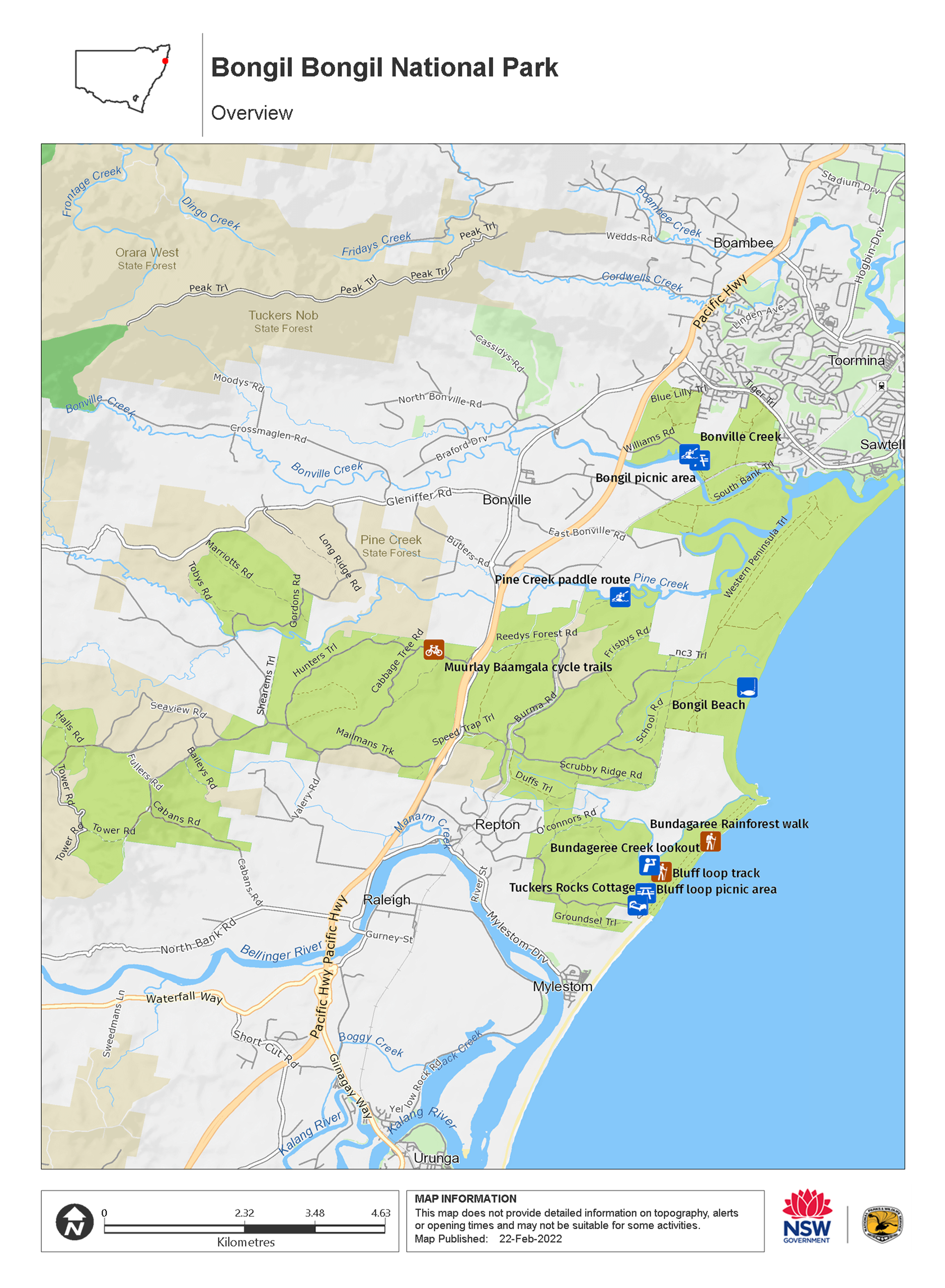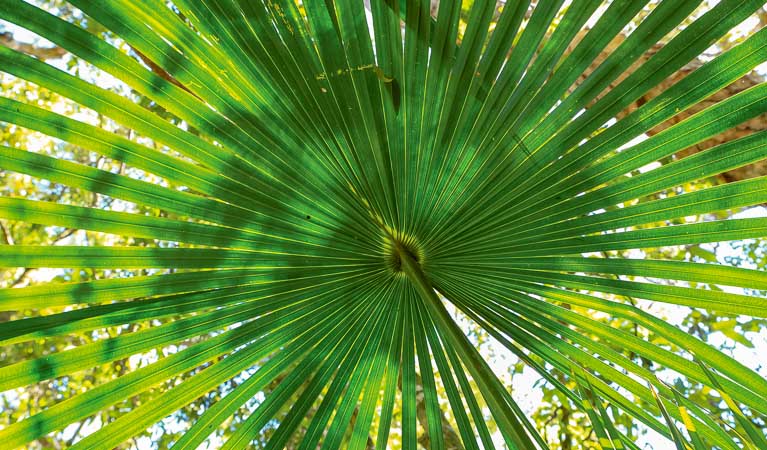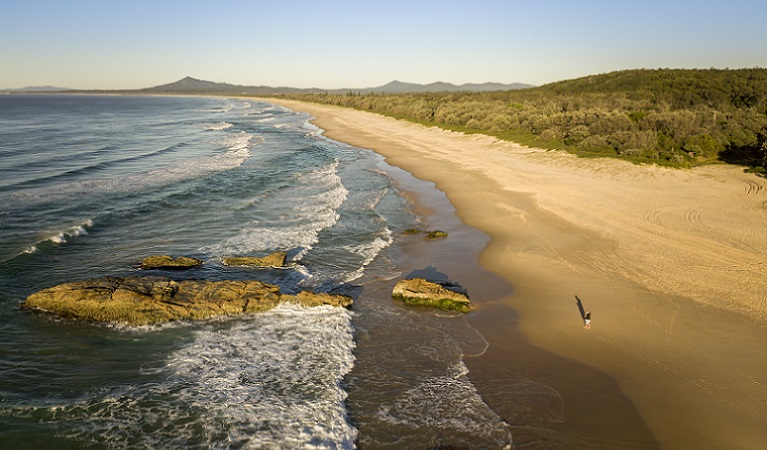Bongil Bongil National Park
Overview
Bongil Bongil National Park, near Coffs Harbour on the NSW north coast is a great spot for fishing and barbecues, great for a day trip or school excursions. It is also home to a large population of koalas.
Read more about Bongil Bongil National Park
The park is on Gumbaynggirr Country and has plenty to offer, including wild beaches, sweeping coastal views and peaceful streams.
This Ecotourism certified national park is popular with locals for a spot of fishing, either on the pontoon by Bonville creek or on the beach around Bundagen Head. Picnic and barbecue facilities are available nearby and there are opportunities for both beach and rainforest walking. The park is also a regional favourite for mountain bike adventures.
The rainforest of Bongil Bongil National Park provides habitat for migrating birds and animals, and surrounding eucalypt forests are home to one of NSW’s largest koala populations. You might see them sleeping in the treetops or munching on leaves.
With so much to offer visitors, it’s no wonder Bongil Bongil is a popular beach holiday destination. Guided tours are available during school holidays and holiday accommodation is available at Bundagen Cottage at Tuckers Rocks.
Local alerts
For the latest updates on fires, closures and other alerts in this area, see https://uat.nswparks.cloud/visit-a-park/parks/bongil-bongil-national-park/local-alerts
Map

Map legend

Contact
- in the North Coast region
Bongil Bongil National Park is always open but may have to close at times due to poor weather or fire danger.
-
-
Coffs Harbour office
02 6652 0900
Contact hours: Monday to Friday, 8.30am to 4.30pm. - 4/32 Edgar St, Coffs Harbour NSW 2450
-
Email: npws.coffscoast@environment.nsw.gov.au
-
Coffs Harbour office
Visitor info
All the practical information you need to know about Bongil Bongil National Park.
Maps and downloads
Nearby towns
Sawtell (1 km)
Sawtell is a beautiful town framed by beaches and a national park.
Coffs Harbour (10 km)
Coffs Harbour is a coastal city on the North Coast, packed with things to do. It's surrounded by lush forests and national parks.
Urunga (16 km)
Urunga is a tranquil holiday resort and one of the State's secret treasures. The town is set on a coastal location at the mouth of the Bellinger and Kalang rivers.
Learn more
Bongil Bongil National Park is a special place. Here are just some of the reasons why:
Birdwatcher's haven

In addition to being home to one of NSW's largest koala populations, Bongil Bongil National Park also boasts more than 165 species of birds. The park provides breeding, roosting and feeding habitats for a number of migratory birds like the little tern and the pied oystercatcher. The Bundageree Rainforest walk is the best place to see the birds of the rainforest, like the dramatically beautiful wompoo fruit dove and the colourful rose-crowned fruit dove that makes a loud and explosive "hookco" sound.
- Pine Creek paddle route Adventurous canoeists, kayakers, and stand-up paddle boarders will enjoy this downstream route along pristine Pine Creek, a wildlife haven in Bongil Bongil National Park, near Coffs Harbour.
Beaches and waterways

The waterways within Bongil Bongil National Park carry water across the coastal plains from the steep foothills to the west, providing a home for many types of birds, animals and reptiles. For visitors, the waterways and beaches in Bongil Bongil National Park offer a range of water activities, including excellent fishing and kayaking. Try your luck on the Bonville river for flathead and whiting.
A place where one stays a long time

Bongil Bongil National Park is the traditional land of the Gumbaynggir people, whose ancestral lands extend from Grafton in the north to the Nambucca river in the south, and from the coast west to the headwaters of the Nymboida river. The park provided abundant seafood and bushtucker, and was a site for gatherings and sacred ceremonies.
- Bush tucker Bush tucker is a Stage 4 (Years 7-8) school excursion to Bongil Bongil National Park, which focuses on Geography. Join our Aboriginal Discovery rangers for an easy stroll along the forested banks of Bonville Creek, to investigate the rich diversity of plants and animals in the park.
- Bush tucker Bush tucker in Bongil Bongil National Park is a school excursion for Stage 2 (Years 3-4) students with a focus on Geography and History. Join our Aboriginal Discovery rangers for an easy stroll along the forested banks of Bonville Creek, to investigate the rich diversity of plants and animals in the park.
- Bush tucker in Bongil Bongil National Park Share the bush secrets of the traditional Gumbaynggirr People in Bush tucker – a Stage 3 (Years 5-6) excursion in Bongil Bongil National Park. Aboriginal guides will reveal their special connection to Country and their secrets for health, wellness and survival.
Plants and animals protected in this park
Animals
-

Koala (Phascolarctos cinereus)
One of the most renowned Australian animals, the tree-dwelling marsupial koala can be found in gum tree forests and woodlands across eastern NSW, Victoria and Queensland, as well as in isolated regions in South Australia. With a vice-like grip, this perhaps most iconic but endangered Australian animal lives in tall eucalypts within a home range of several hectares.
-

Grey-headed flying-fox (Pteropus poliocephalus)
The grey-headed flying fox is Australia's largest native bat, with a wingspan up to 1m. This threatened species travels up and down south-eastern Australia and plays a vital role in pollinating plants and spreading seeds in our native forests.
-

Lace monitor (Varanus varius)
One of Australia’s largest lizards, the carnivorous tree-dwelling lace monitor, or tree goanna, can grow to 2m in length and is found in forests and coastal tablelands across eastern Australia. These Australian animals are typically dark blue in colour with whitish spots or blotches.
Plants
-

Grey mangrove (Avicennia marina)
Grey mangrove is the most common and widespread mangrove found within intertidal zones across Australia, and throughout the world. Growing to a height of 3-10m, they thrive best in estuaries with a mix of fresh and salt water. They excrete excess salt through their long thick leaves, and absorb oxygen through their aerial root system.
-

Blueberry ash (Elaeocarpus reticulatus)
The blueberry ash is a rainforest shrub which produces blue olive-shaped berries and spectacular bell-shaped flowers, which often appear on the plant together. It is a tall slender shrub or small tree found in rainforest, tall eucalypt forest and coastal bushland in eastern NSW, south-east Queensland and Victoria.
Environments in this park
Education resources (1)
School excursions (3)
- Bush tucker in Bongil Bongil National Park, Stage 3 (Years 5-6), Geography
- Bush tucker, Stage 4 (Years 7-8), Geography
- Bush tucker, Stage 2 (Years 3-4), Geography
What we're doing
Bongil Bongil National Park has management strategies in place to protect and conserve the values of this park. View the detailed park and fire management documents. Here is just some of the work we’re doing to conserve these values:
Preserving biodiversity
Bongil Bongil National Park embraces programs dedicated to preserving vulnerable, threatened and endangered species, and involves the community in efforts to maintain its biodiversity. Volunteer programs take place in this park and include surveying vulnerable species, such as koalas. Efforts to minimise threats to such plant, animal and bird species are ongoing.
Managing weeds, pest animals and other threats
Pests and weeds have a significant impact on the ecosystems within Bongil Bongil National Park. Pest reduction of foxes is an important part of the work NPWS does to protect the integrity of biodiversity within the park. Risk assessments for new and emerging weeds are carried out as an ongoing initiative in the area.
Developing visitor facilities and experiences
NPWS is dedicated to providing outstanding facilities and experiences for visitors to all NSW national parks. Amenities in Bongil Bongil National Park, including tourist accommodation, receive ongoing management and maintenance.
Managing fire
NSW is one of the most bushfire prone areas in the world as a result of our climate, weather systems, vegetation and the rugged terrain. NPWS is committed to maintaining natural and cultural heritage values and minimising the likelihood and impact of bushfires via a strategic program of fire research, fire planning, hazard reduction, highly trained rapid response firefighting crews and community alerts.

